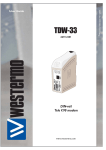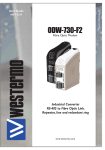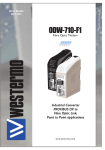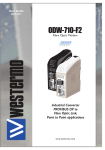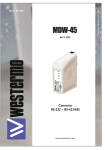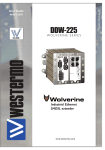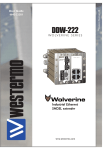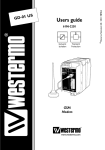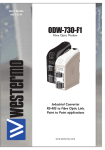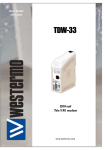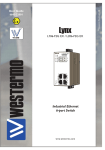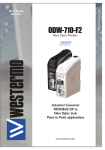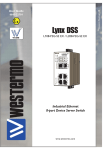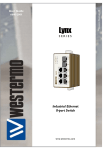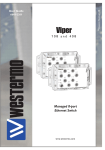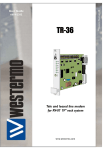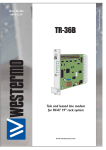Download ODW-621/631 - RS Components International
Transcript
ODW-621/631 Fibre Optic Modem 6650-2221 Industrial Converter Serial to Fibre optic link. Point to point applications www.westermo.com © Westermo Teleindustri AB • 2006 User Guide Legal information The contents of this document are provided “as is”. Except as required by applicable law, no warranties of any kind, either express or implied, including, but not limited to, the implied warranties of merchantability and fitness for a particular purpose, are made in relation to the accuracy and reliability or contents of this document. Westermo reserves the right to revise this document or withdraw it at any time without prior notice. Under no circumstances shall Westermo be responsible for any loss of data or income or any special, incidental, and consequential or indirect damages howsoever caused. More information about Westermo can be found at the following Internet address: http://www.westermo.com 2 6650-2221 Safety ! Before installation: Read this manual completely and gather all information on the unit. Make sure that you understand it fully. Check that your application does not exceed the safe operating specifications for this unit. This unit should only be installed by qualified personnel. This unit should be built-in to an apparatus cabinet, or similar, where access is restricted to service personnel only. The power supply wiring must be sufficiently fused, and if necessary it must be possible to disconnect manually from the power supply. Ensure compliance to national installation regulations. This unit uses convection cooling. To avoid obstructing the airflow around the unit, follow the spacing recommendations (see Cooling section). ! Before mounting, using or removing this unit: Prevent access to hazardous voltages by disconnecting the unit from the power supply. Warning! Do not open a connected unit. Hazardous voltages may occur within this unit when connected to a power supply. ! Class 1 Laser Product This unit is designed to meet the Class 1 Laser regulations. However, the user is warned not to look directly into fibre optical port or any connected fibre. Care recommendations Follow the care recommendations below to maintain full operation of the unit and to fulfil the warranty obligations. This unit must not be operated with covers or lids removed. Do not attempt to disassemble the unit. There are no user serviceable parts inside. Do not drop, knock or shake the unit. Rough handling beyond the specification may cause damage to internal circuit boards. Do not use harsh chemicals, cleaning solvents or strong detergents to clean the unit. Do not paint the unit. Paint can clog the unit and prevent proper operation. Do not expose the unit to any kind of liquids (rain, beverages, etc). The unit is not waterproof. Keep the unit within the specified humidity levels. Do not use or store the unit in dusty, dirty areas. Connectors as well as other mechanical parts may be damaged. If the unit is not working properly, contact the place of purchase, nearest Westermo distributor office, or Westermo Tech support. Fibre connectors are supplied with plugs to avoid contamination inside the optical port. The plug should be fitted when no optical fibre is inserted in the connector, e.g. during storage, service or transportation. 6650-2221 3 Note. Fibre Optic Handling Fibre optic equipment requires careful handling as the fibre components are very sensitive to dust and dirt. If the fibre is disconnected from the modem, the protective plug on the transmitter/receiver must be replaced. The protective plug must be kept on during transportation. The fibre optic cable must also be protected in the same way. If this recommendation is not followed, it can jeopardise the warranty. Cleaning of the optical connectors In the event of contamination, the optical connectors should be cleaned by using forced nitrogen and some kind of cleaning stick. Recommended cleaning fluids: • Methyl-, ethyl-, isopropyl- or isobutyl-alcohol • Hexane • Naphtha Maintenance No maintenance is required, as long as the unit is used as intended within the specified conditions. Agency approvals and standards compliance Type Approval / Compliance EMC EN 61000-6-2, Immunity industrial environments EN 55024, Immunity IT equipment EN 61000-6-3, Emission residential environments FCC part 15 Class B EN 50121-4, Railway signalling and telecommunications apparatus IEC 62236-4, Railway signalling and telecommunications apparatus Safety EN 60950-1, IT equipment FCC Part 15.105 Notice: 4 This equipment has been tested and found to comply with the limits for a Class B digital device, pursuant to Part 15 of the FCC Rules. These limits are designed to provide reasonable protection against harmful interference in a residential installation. This equipment generates, uses and can radiate radio frequency energy and, if not installed and used in accordance with the instructions, may cause harmful interference to radio communications. However, there is no guarantee that interference will not occur in a particular installation. If this equipment does cause harmful interference to radio or television reception, which can be determined by turning the equipment off and on, the user is encouraged to try to correct the interference by one or more of the following measures: … Reorient or relocate the receiving antenna … Increase the separation between the equipment and receiver … Connect the equipment into an outlet on a circuit different from that to which the receiver is connected … Consult the dealer or an experienced radio/TV technician for help. 6650-2221 Declaration of Conformity Westermo Teleindustri AB Declaration of conformity The manufacturer Westermo Teleindustri AB SE-640 40 Stora Sundby, Sweden Herewith declares that the product(s) Type of product Model Art no Installation manual Industrial Converter, PROFIBUS DP to fibre optic link ODW-611 3650-0001, 3650-0010 3650-0020, 3650-0030 3650-0501, 3650-0510 3650-0520, 3650-0530 3650-0101, 3650-0110 3650-0120, 3650-0130 3650-0601, 3650-0610 3650-0620, 3650-0630 3650-0201, 3650-0210 3650-0220, 3650-0230 3650-0701, 3650-0710 3650-0720, 3650-0730 6650-2201 ODW-612 Industrial Converter, RS-232 to fibre optic link ODW-621 ODW-622 Industrial Converter, RS-485 to fibre optic link ODW-631 ODW-632 6650-2211 6650-2221 6650-2231 6650-2221 6650-2231 is in conformity with the following EC directive(s). No Short name 89/336/EEG Electromagnetic Compatibility (EMC) References of standards applied for this EC declaration of conformity. No Title Issue EN 61000-6-2 EN 55024 EN 61000-6-3 Immunity for industrial environments Information technology equipment – Immunity Emission standard for residential, commercial and light-industrial environments 2 (2001) 1 (1998) 1 (2001) Herewith declares that product(s) listed above is in conformity with No Title Issue FCC part 15 Radio frequency devices 2003 Hans Levin Technical Manager 15th March 2006 Postadress/Postal address Tel. Telefax Postgiro Bankgiro Org.nr/ Corp. identity number Registered office S-640 40 Stora Sundby 016-428000 016-428001 52 72 79-4 5671-5550 556361-2604 Eskilstuna Sweden Int+46 16428000 Int+46 16428001 6650-2221 5 Type tests and environmental conditions Electromagnetic Compatibility Phenomena Test ESD EN 61000-4-2 RF field AM modulated RF field 900 MHz Fast transient IEC 61000-4-3 ENV 50204 EN 61000-4-4 Surge EN 61000-4-5 RF conducted EN 61000-4-6 Power frequency magnetic field Pulse Magnetic field Voltage dips and interruption EN 61000-4-8 Description Enclosure contact Enclosure air Enclosure Enclosure Signal ports Power ports Signal ports unbalanced Signal ports balanced Power ports Signal ports Power ports Enclosure EN 61000-4-9 EN 61000-4-11 Enclosure AC power ports Mains freq. 50 Hz Mains freq. 50 Hz Voltage dips and interruption EN 61000-4-16 SS 436 15 03 EN 61000-4-29 Signal ports Signal ports DC power ports Radiated emission EN 55022 FCC part 15 EN 55022 FCC part 15 EN 55022 EN 60950 Enclosure Conducted emission Dielectric strength Environmental Temperature Humidity Altitude Service life Vibration Shock Packaging Enclosure Dimension W x H x D Weight Degree of protection Cooling Mounting 6 IEC 60068-2-6 AC power ports AC power ports DC power ports Signal port to all other isolated ports Power port to other isolated ports Operating Storage & Transport Operating Storage & Transport Operating Operating Operating IEC 600682-27 Operating UL 94 PC / ABS IEC 529 Enclosure Level ± 6 kV ± 8 kV 20 V/m 80% AM (1 kHz), 80 – 2000 MHz 20 V/m pulse modulated 200 Hz, 900 ± 5 MHz ± 2 kV ± 2 kV ± 2 kV line to earth, ± 2 kV line to line ± 2 kV line to earth, ± 1 kV line to line ± 2 kV line to earth, ± 2 kV line to line 10 V 80% AM (1 kHz), 0.15 – 80 MHz 10 V 80% AM (1 kHz), 0.15 – 80 MHz 100 A/m, 50 Hz, 16.7 Hz & 0 Hz 300 A/m, 6.4 / 16 μs pulse 10 & 5 000 ms, interruption 10 & 500 ms, 30% reduction 100 & 1 000 ms, 60% reduction 100 V 50 Hz line to earth 250 V 50 Hz line to line 10 & 100 ms, interruption 10 ms, 30% reduction 10 ms, 60% reduction +20% above & –20% below rated voltage Class B Class B Class B Class B Class B 2 kVrms 50 Hz 1min 3 kVrms 50 Hz 1min 2 kVrms 50 Hz 1min (@ rated power < 60V) –40 to +55°C –40 to +70°C 5 to 95% relative humidity 5 to 95% relative humidity 2 000 m / 70 kPa 10 year 7.5 mm, 5 – 8 Hz 2 g, 8 – 500 Hz 15 g, 11 ms Flammability class V-1 35 x 121 x 119 mm 0.26 kg IP 21 Convection Horizontal on 35 mm DIN-rail 6650-2221 Description This ODW-600 is a fibre optic modem used for point to point applications. It acts as a converter between a serial port and a fibre optical link. The maximum distance of the fibre link depends on selected transceiver and fibre type. Distance up to 80 km (50 miles) is available. The ODW-600 is designed for harsh out-door usage, in industrial, road or railway installations. Data will be sent transparently over the fibre optical link via the serial interface RS-232 (ODW-621) or RS-485 (ODW-631). … Converter serial interface – optical fibre. … Point to point communication via fibre optical network. … Serial interface transparent or protocol dependent. … RS-232 interface (ODW-621). • 9-position D-sub connector. • Data rate up to 250 kbit/s. • RTS/CTS control or data control. … RS-485 interface (ODW-631). • 4 positions detachable screw terminal. • Data rate up to 1.5 Mbit/s. • 2- or 4-wire RS-485. • Small Form Factor Pluggable (SFP) transceivers. • LC fibre connectors, single- or multimode. • Fibre distance up to 80 km. • Redundant DC or AC power supply, 2 kVAC galvanic isolated to other ports. • Status port. • Designed for hash environments. 6650-2221 7 Functional description Switches LED’s +5V POWER +VA +VB O V P 0V O V P Internal Electronics COM ODW-631 +5V RS -485 T/R T/R+ RR+ O C P 0V COM ODW-621 STATUS NO C NC RS -232 DCD RD TD SG DSR RTS CTS O V P SHIELD CH 1 OVP Over Voltage Protection OCP Over Current Protection TX RX SFP Fibre transceiver Converter serial interface – optical fibre ODW-621/631 is a fibre optic modem that converts between electrical RS-232 or RS-485 and a fibre optic link. ODW-621/631 can also be used to convert from RS-232 to RS-485 by using one ODW-621 and one ODW-631. Repeater – optical fibre links ODW-621/631 is a fibre optic repeater that repeats received data from one fibre link out to the other link. This is useful e.g. for long distance communication, where electromagnetic interference may occur or when isolation of the electrical network is needed. The maximum optical fibre distance depends on selected fibre transceiver and fibre type. Distances up to 80 km (50 miles) are available. Data rate up to RS-232 – 250 kbit/s, RS-485 – 1.5 Mbit/s ODW-621/631 converts data using rates from 300 bit/s up to 250 kbit/s (RS-232) or from 300 bit/s up to 1.5 Mbit/s. (RS-485) Retiming of the data ensures that the correct signal form is transmitted from the ODW-621/631 converter. 8 6650-2221 Point to point communication via fibre optical network The serial interface is transferred via a fibre optic network between two ODW-600s. This application is useful e.g. for long distance communication, where electromagnetic interference may occur or when isolation of the electrical network is needed. The maximum optical fibre distance between two units depends on selected fibre transceiver and fibre type. Distance up to 80 km (50 miles) are available. POWER COM +VA +VB COM CH 1 TX RX POWER COM +VA +VB COM CH 1 TX RX Fibre optical connection at point to point communication Serial interface fully transparent or protocol dependent Serial data transfer can be set in two modes: … Transparent: Data will be directly sent over the fibre optic network, without any start-bit control and without any turning time delay when using the RS-485 interface. This is only recommended when the date is an unidentified protocol or data rate. This mode is not recommended when using RTS/CTS control or RS-485 two-wire. … Protocol dependent: Data will be sent over the fibre optic network when a startbit has been identified. The data rate and number of data bits should be set by DIP-switches. The turning time (from sending serial RS-485 data until changing to receive mode) is automatically calculated from the DIP-switch setting. This is the preferred mode. 6650-2221 9 RS-485 termination at system level The system should be installed in according to the RS-485 specification. A system should always form a bus structure where the termination is at the end points of the bus. See diagrams for details of how this is done with RS-485 2-wire and 4-wire. R+ R– T+ T– R– R+ T– T+ R– R+ T– T+ ODW-631 R– R+ T– T+ =Termination Slave unit Slave unit Slave unit T/R+ T/R– Max 0.3 metre ODW-631 T/R– T/R+ T/R– T/R+ T/R– T/R+ =Termination Slave unit 10 Slave unit Slave unit 6650-2221 Optical fibre link functionality and status indication At power on, all LED’s will be active during an initiation sequence followed by an automatic initiation of the optical fibre link. The alarm will be set until the fibre optic link is in operation and ready to transfer serial data. Data can be transferred over the fibre optic link as long as the link is in operation. When the fibre optic link is out of operation this will be indicated by a local alarm output. When the link returns to operation, the alarm will reset automatically. RS-232 interface (ODW-621) A 9-position female D-sub connector that handles full duplex data rates up to 250 kbit/s. With transparent mode the RS-232 interface can handle an arbitrary data rate up to 250 kbit/s without any data rate or data bit settings. With protocol dependent mode, one of the data rates from 300 bit/s to 250 kbit/s and one of the word formats (9 to 12 data bits) should be set. With RTS/CTS control selected, the request to send (RTS) signals will be transferred between the ODW-621s over the fibre optic network. These RTS signals are transferred independently of the data transfer. An RTS signal received at one ODW-600 will set the clear to send (CTS) signal at the other converter. The data carrier detect (DCD) signal is set as long as the fibre link is in operation, ready to transfer data. The data set ready (DSR) signal is set as long as the ODW-600 is in service. RS-485 interface (ODW-631) A 4 position detachable screw terminal that can handle full duplex data rates up to 1.5 Mbit/s and can be set to either 2- or 4-wire RS-485 system. When 4-wire RS-485 is selected, the terminals T/R+ and T/R– will always be set to transmit and terminals R+ and R– will always receive data. Redundant power supply, galvanic isolated (2 kVAC) to other ports The ODW-600 should be supplied with safety extra low voltage (SELV). It is designed to operate permanently over a wide DC or AC voltage input range and provided with two independent inputs for enhanced redundancy if either supply fails. Single- or multimode LC fibre connectors The ODW-600 uses Small Form Factor Pluggable (SFP) transceivers that are in compliance with Multi-Sourcing Agreement (MSA). A wide range of different fibre transceivers and connectors can be used. Status interface This port enables supervision of fibre optic link status by a relay with both normally open and closed contacts. The status will be set if: • Local or remote of fibre link errors exist. • The unit is out of service, e.g. no power supply. 6650-2221 11 Designed for hash environments, such as industrial, road and railway applications The ODW-600 complies with standards for industrial environments, railway signalling and telecommunications apparatus. Additionally the wide temperature range permits it to be installed in out-door cabinets without any additional measures, such as heating, etc. System delay in an optical network Serial data transferred from one ODW-600 via an optical network to a second one, will be delayed due to the length of optical fibre and the signal processing within the units. The signal processing delay is dependent on the data rate and conversions, and the fibre delay is dependent on the total length of the optical fibre. Item Functions Delay 1 Fibre: Optical fibre length delay (typical) 5 μs/km 2 Converter electrical to fibre: Signal processing 0.6 μs (Transparent mode) 1 tBit + 0.6 μs (Protocol dependent mode) 3 Converter fibre to electrical: Signal processing 0.6 μs Note tbit = 1 / Baud rate (Baud rate in bit/s) 12 6650-2221 The system delay when transferring data from the serial input at one ODW-600 to the serial output of other one is calculated by adding the following: 1. Fibre: The optical fibre length delay. 2. Converter electrical to fibre: Signal processing delay. 3. Converter fibre to electrical: Signal processing delay. Example 1: Protocol dependent data transfer from one ODW-600 to a second converter with a total fibre length of 25 km. Data rate of 9 600 bit/s. 1. Fibre: The total optical fibre length delay 25 * 5 μs = 125 μs. 2. Converter electrical to fibre: Signal processing delay 1 tbit + 0.6 μs = 105 μs + 1.0 μs = 106 μs. 3. Converter fibre to electrical: Signal processing delay = 0.6 μs. 4. The system delay is calculated by adding the delays in items 1 to 3 above = 232 μs Example 2: Transparent data transfer from one ODW-600 to a second converter with a total fibre length of 25 km. Data rate of 9 600 bit/s. 5. Fibre: The total optical fibre length delay 25 * 5 μs = 125 μs. 6. Converter electrical to fibre: Signal processing delay = 0.6 μs. 7. Converter fibre to electrical: Signal processing delay = 0.6 μs. 8. The system delay is calculated by adding the delays in item 1 to 3 above = 126 μs 6650-2221 13 Interface specifications Power Rated voltage Operating voltage Rated current Rated frequency Inrush current I2t Startup current* Polarity Redundant power input Isolation to Connection Connector size Shielded cable 12 to 48 VDC 24 VAC 10 to 60 VDC 20 to 30 VAC 300 mA @ 12 V 150 mA @ 24 V 75 mA @ 48 V DC; 48 to 62 Hz 0.2 A2s 1.0 Apeak Polarity independent Yes Serial port and Status port Detachable screw terminal 0.2 – 2.5 mm2 (AWG 24 – 12) Not required * External supply current capability for proper startup RS-422/485 Electrical specification Data rate Data format Retiming Deviation, Input data rate Turning time (2-wire RS-485) Transmission range Settings Protection Isolation to Connection Connector size Shielded cable EIA RS-485, 2-wire or 4-wire twisted pair 300 bit/s – 1.5 Mbit/s 9 – 12 bits (Protocol dependent mode) Arbitrary (Transparent mode) Start-bit followed by 8-11 bits (Protocol dependent mode) Arbitrary (Transparent mode) Yes (Protocol dependent mode) Byte: 4%; Bit 49% (Protocol dependent mode) One tbit tbit = 1 / Baud rate (Baud rate in bit/s) < 1200 m, depending on data rate and cable type (EIA RS-485) 120 Ω termination and failsafe biasing 680 Ω Installation Fault Tolerant (up to ±60 V) Status and Power port Detachable screw terminal 0.2 – 2.5 mm2 (AWG 24 – 12) Not required Status Port type Rated voltage Operating voltage Contact rating Contact resistance Isolation to Connection Connector size Shielded cable Signal relay, changeover contacts Up to 48 VDC Up to 60 VDC 500 mA @ 48 VDC < 50 mΩ Serial port and Power port Detachable screw terminal 0.2 – 2.5 mm2 (AWG 24 – 12) Not required Protocol 14 6650-2221 RS-232 Electrical specification Data rate Data format Protocol Retiming Deviation, Input data rate Transmission range Isolation to Connection Shielded cable Conductive housing EIA RS-232 300 bit/s – 250 kbit/s 9 – 12 bits (Protocol dependent mode) Arbitrary (Transparent mode) Start-bit followed by 8 – 11 bits (Protocol dependent mode) Arbitrary (Transparent mode) Yes (Protocol dependent mode) Byte: 4%; Bit 49% (Protocol dependent mode) 15 m Status and Power port 9-pin D-sub female (DCE) Not required, except when installed in railway applications as signalling and telecommunications apparatus and located close to rails* Isolated to all other circuits and housings * To minimise the risk of interference, a shielded cable is recommended when the cable is located inside 3 m boundary to the rails and connected to this port. The cable shield should be properly connected (360°) to an earthing point within 1 m from this port. This earthing point should have a low impedance connection to the conductive enclosure of the apparatus cabinet, or similar, where the unit is built-in. This conductive enclosure should be connected to the earthing system of an installation and may be directly connected to the protective earth. FX (Fibre) Fibre connector Fibre type SM-LC80 LC duplex Singlemode 9/125 μm SM-LC40 LC duplex Singlemode 9/125 μm SM-LC15 LC duplex Singlemode 9/125 μm Wavelength Transmitter Output optical power min/max Receiver Input sensitivity, max Receiver Input optical power, max Optical power budget, worst-case Bit error rate (BER) Transceiver type 1550 nm –5/0 dBm** 1310 nm –5/0 dBm** 1310 nm –15/–8 dBm** MM-LC2 LC duplex Multimode, 62.5/125 and 50/125 μm 1310 nm –20/–14 dBm* –34 dBm –34 dBm –31 dBm –31 dBm –5 dBm*** –3 dBm*** –8 dBm –8 dBm 29 dBm 29 dBm 16 dBm 11 dBm Laser class * ** *** < 1 x 10-10 < 1 x 10-10 < 2.5 x 10-10 < 1 x 10-10 Small Form Factor Pluggable (SFP) Multi-Sourcing Agreement (MSA) compliant Class 1, IEC 825-1 Accessible Emission Limit (AEL) Output power is power coupled into a 62.5/125 μm multimode fibre Output power is power coupled into a 9/125 μm singlemode fibre The optical power should be reduced by at least 5 dB (SM-LC80) or 3dB (SM-LC80) between the optical output and input. Optical Power Budget The allowed link length is calculated from the optical power budget (OPB), the available optical power for a fibre-optic link, and the attenuation of the fibre, comprising losses due to in-line connectors, splices, optical switches and a margin for link ageing (typical 1.5 dB for 1300 nm). The worst-case optical power budget (OPB) in dB for a fibre-optic link is determined by the difference between the transmitter’s output optical power (min) and the receiver input sensitivity (max). 6650-2221 15 Location of Interface ports, LED’s and DIP-switches ODW-631 DIP-switches accessible under lid (for details see page 17-18) LED Indicators (for details see page 16) Status screw terminal Position Direction 1 NO 2 3 C NC Description Contact with C when fibre optical links are in operation Common Open (no contact with C) when fibre optical links are in operation FX(Fibre) (for details see next page) Product marking NO C NC NC Not connected Power screw terminal Position Direction* 1 In 2 3 4 In In In Description Common voltage Voltage A Voltage B Common voltage Product marking COM +VA +VB COM RS-422/485 screw terminal * 16 Position Direction* Description Product marking 1 In R+ (EIA RS-485 A’) R+ 2 In R– (EIA RS-485 B’) R– 3 In/Out T+ (EIA RS-485 A) T/R+ 4 In/Out T– (EIA RS-485 B) T/R– Direction relative this unit 6650-2221 ODW-621 LED Indicators (for details see page 17-18) Status screw terminal Position Direction 1 NO 2 3 C NC Description Contact with C when fibre optical links are in operation Common Open (no contact with C) when fibre optical links are in operation Product marking NO C NC NC Not connected RS-232 D-sub Position D-sub 1 2 3 4 5 6 7 8 9 Direction* Out Out In – Out In Out Position Direction* Description Product marking Left Out Transmit data TX Right In Receive data RX Description Data Carrier Detect (DCD) Received Data (RD) Transmitted Data (TD) NC Signal Ground (SG) Data Set Ready (DSR) Request To Send (RTS) Clear To Send (CTS) NC * Direction relative this unit 6650-2221 17 LED indicators LED Status Description PWR ON In service (power) Flashing Fault condition OFF Out of service RDR OFF Not used CH 2 OFF Not used CH 1 ON Fibre link at port CH 1 in operation. Data can be transmitted OFF Fibre link at port CH 1 out of operation Flashing Receive accepted data on the serial port. Data will be transmitted to the fibre link OFF – Flashing Receive data on the fibre link. This frame is transmitted to the serial port OFF – ON Remote fibre link failure. A fibre link is out of operation at any other unit of the optical network OFF All fibre links are in operation at all other units in the fibre optical network ON Local fibre link failure. This unit has identified a fibre link failure OFF Fibre link of this unit is in operation Power TD Serial data Receive RD Fibre link data Receive FL R (Red) Failure Link Remote FL L (Red) Failure Link Local 18 6650-2221 Configuration All needed configurations and parameter settings are done by the DIP-switches, located under the top lid of the ODW-600. S1 S2 S3 ! DIP-switch settings Before DIP-switch settings: Prevent damage to internal electronics from electrostatic discharges (ESD) by discharging your body to a grounding point (e.g. use of wrist strap) S1 DIP-switch ON ON Data control 1 2 3 4 5 6 7 8 38.4 kbit/s 1 2 3 4 5 6 7 8 ON ON RTS/CTS control 1 2 3 4 5 6 7 8 57.6 kbit/s 1 2 3 4 5 6 7 8 ON ON RS-485 2-wire 1 2 3 4 5 6 7 8 115.2 kbit/s 1 2 3 4 5 6 7 8 ON ON RS-485 4-wire 1 2 3 4 5 6 7 8 125 kbit/s 1 2 3 4 5 6 7 8 ON ON 300 bit/s 1 2 3 4 5 6 7 8 230.4 kbit/s 1 2 3 4 5 6 7 8 ON ON 1 200 bit/s 1 2 3 4 5 6 7 8 250 kbit/s 1 2 3 4 5 6 7 8 ON ON 2 400 bit/s 1 2 3 4 5 6 7 8 500 kbit/s 1 2 3 4 5 6 7 8 ON ON 4 800 bit/s 1 2 3 4 5 6 7 8 1 Mbit/s 1 2 3 4 5 6 7 8 ON ON 9 600 bit/s 1 2 3 4 5 6 7 8 1.5 Mbit/s 1 2 3 4 5 6 7 8 ON 19.2 kbit/s 1 2 3 4 5 6 7 8 6650-2221 19 S1 DIP-switch ON ON 9 bits data format 11 bits data format 1 2 3 4 5 6 7 8 1 2 3 4 5 6 7 8 ON ON 10 bits data format 12 bits data format 1 2 3 4 5 6 7 8 1 2 3 4 5 6 7 8 S2 DIP-switch ON 1 2 3 4 5 6 7 8 ON 1 2 3 4 5 6 7 8 Transparent mode, without any start-bit control ON Protocol dependent mode, with start-bit control ON 1 2 3 4 5 6 7 8 1 2 3 4 5 6 7 8 Set status port at local or remote fibre link error Set status port at local fibre link error S3 DIP-switch ON ON No termination and fail-safe Termination with fail-safe (2-wire) 1 2 3 4 1 2 3 4 ON Termination with fail-safe (4-wire) 1 2 3 4 Factory settings ON S1 1 2 3 4 5 6 7 8 20 ON S2 ON S3 1 2 3 4 5 6 7 8 1 2 3 4 6650-2221 Mounting This unit should be mounted on 35 mm DIN-rail, which is horizontally mounted inside an apparatus cabinet, or similar. Snap on mounting, see figure. CLICK! Cooling This unit uses convection cooling. To avoid obstructing the airflow around the unit, use the following spacing rules. Minimum spacing 25 mm (1.0 inch) above /below and 10 mm (0.4 inches) left /right the unit. Spacing is recommended for the use of unit in full operating temperature range and service life. 10 mm * (0.4 inches) * Spacing (left/right) recommended for full operating temperature range 25 mm 25 mm Removal Press down the black support at the top of the unit. See figure. 6650-2221 21 Start up guide, point to point application Follow the steps below to get the unit up and running in a simple application. Master POWER COM +VA +VB COM Slave CH 1 TX RX POWER COM +VA +VB COM CH 1 TX RX … Configure the ODW-600s. Using the factory DIP-switch settings, set: … S1: RS-232 or 2-wire RS-485, data control, 9 600 bit/s, 10 data bits (e.g. 8 data bits, 1 start and 1 stop bit, no parity). … S2: Protocol dependent mode, with start-bit control. … S3: No termination and fail-safe of the RS-485 port. … Connect The fibre link between the ODW-600s. … Connect the power supply to both ODW-600s. … After a few seconds the fibre link should be in operation, indicated by an active CH1 LED. … Connect the serial cables from PLC master and slave to respective ODW-600s. … Frames from PLC master that are correctly received the ODW-600 should be indicated by flashing TD LED. … Frames that are received via the fibre link will be transmitted to the PLC slave and indicated by flashing RD LED. … Replies from slave to master will be transferred and indicated in the opposite way. … The point to point application is up and running. 22 6650-2221 Hints If the distance is too long, it may be necessary to adjust the timing of the sender of the frame to allow acknowledgement of of the received frame, during configuration of the PLC master. Ensure that the correct protocol dependent configuration has been selected. Flashing of the TD LED indicates that a start-bit has been identified. If protocol parameters, data rate and bits are unknown. Transparent mode may be used as an alternative, as long as 2-wire RS-485 is not used. The definition of positive and negative T/R+, T/R– and R+, R– can differ between this ODW-600 and other units so it can be helpful to reverse the connection of + and –. 6650-2221 23 Subsidiaries Westermo OnTime AS Gladsvei 20 0489 Oslo, Norway Phone +47 22 09 03 03 • Fax +47 22 09 03 10 E-mail: [email protected] Westermo Data Communications GmbH Goethestraße 67, 68753 Waghäusel Tel.: +49(0)7254-95400-0 • Fax.:+49(0)7254-95400-9 E-Mail: [email protected] Westermo Data Communications Ltd Talisman Business Centre • Duncan Road Park Gate, Southampton • SO31 7GA Phone: +44(0)1489 580-585 • Fax.:+44(0)1489 580586 E-Mail: [email protected] Westermo Data Communications S.A.R.L. 9 Chemin de Chilly 91160 CHAMPLAN Tél : +33 1 69 10 21 00 • Fax : +33 1 69 10 21 01 E-mail : [email protected] Westermo Teleindustri AB have distributors in several countries, contact us for further information. REV.A 6650-2221 2006.07 Mälartryck AB, Eskilstuna, Sweden Westermo Teleindustri AB • SE-640 40 Stora Sundby, Sweden Phone +46 16 42 80 00 Fax +46 16 42 80 01 E-mail: [email protected] Westermo Web site: www.westermo.com
























